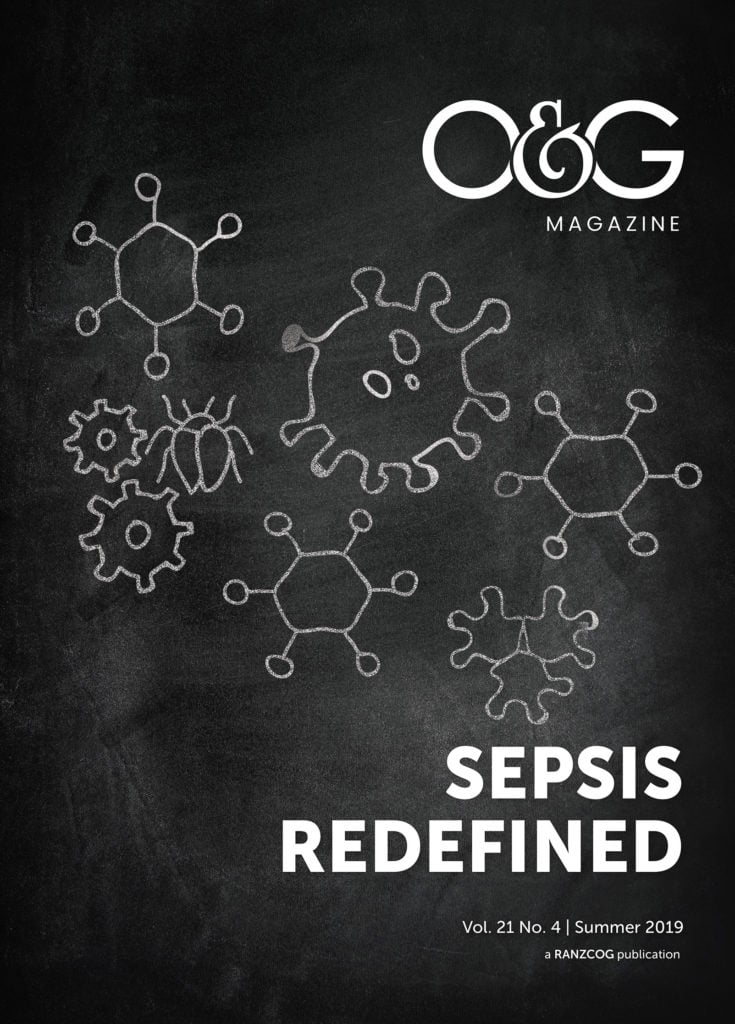The Centers for Disease Control and Prevention define surgical site infection (SSI) as ‘infection occurring in the part of the body where the surgery took place within 30 days of the procedure’.1 In 2016, 34 per cent of Australian mothers gave birth by caesarean section (CS), with more than 106 000 procedures performed.2 Women undergoing CS have a 5- to 20-fold greater risk for puerperal infectious morbidity compared to vaginal birth.3
The most robust strategies for preventing SSI are firstly, to avoid unnecessary CS; secondly, to optimise medical comorbidities (such as glycaemic control) to reduce susceptibility to infection and improve healing; and finally, to maintain best practice in peri-operative management and surgical technique. This review considers the evidence (or lack thereof) for strategies currently employed at CS to reduce the risk of SSI and its consequences.
Pre-operative preparation
Antibiotic prophylaxis
Routine antibiotic prophylaxis at CS is standard practice in Australia, consistent with surgical guidelines internationally. The 2014 Cochrane review on antibiotic administration at CS demonstrated a 60–70 per cent reduction in the incidence of wound infection, endometritis and serious maternal infectious complications with the use of prophylactic antibiotics compared to placebo, for both elective and emergency CS.4
Timing of antibiotic prophylaxis
Prophylactic antibiotic administration is generally timed to establish a bactericidal concentration in serum and tissue prior to surgical incision. At CS, a reasonable concern for potential anaphylaxis or the fetal effects of antibiotic administration may lead to delaying surgical prophylaxis until after the fetus is delivered and the cord is clamped, but the well-established benefit of reduced infectious morbidity generally favours antibiotic administration prior to skin incision over these rarer risks. The 2014 Cochrane review supports this, with almost half the rate of combined infections, endometritis and wound infection reported in women with antibiotics administered pre-operatively, compared to those who received antibiotics after neonatal cord clamping.5
One meta-analysis and one small randomised controlled trial (RCT) performed in China did show no difference in SSI with pre-incision or post-cord-clamping antibiotic administration in elective CS.6 However, neither study suggested a benefit to delayed administration, and despite an unusually low incidence of SSI (1 per cent in the control group), the point estimates from this RCT still appeared to favour a (non-statistically significant) benefit of pre-incision antibiotic prophylaxis. By contrast, a systematic review in 2017 reported unequivocally that pre-operative antibiotics reduced infectious morbidity by 28 per cent compared with administration after cord clamping. There was no significant difference in rates of other maternal infections, neonatal sepsis, ICU admission or the need for neonatal antibiotics.7
Extended prophylaxis with azithromycin
SSI following CS has a distinct microbial signature, with polymicrobial infection commonly comprising organisms of both skin and vaginal origin.8 Most studies include trials of first-generation cephalosporins, but extended spectrum antibiotic cover may further reduce infection rates in high-risk patients, particularly from ureaplasma species, which are commonly associated with endometritis and caesarean-related infection.9 10
A well-powered RCT from the USA showed that adding a single dose of intravenous azithromycin to routine prophylaxis in women with ruptured membranes for greater than four hours undergoing an unplanned CS significantly reduced the number of women with endometritis, wound infection or other infectious morbidity up to six weeks after surgery (6.1 per cent versus 12.0 per cent).11 No increase in adverse outcomes was reported.
The impact of other risk factors, such as obesity, prolonged rupture of membranes and prolonged surgical time, requires more robust evidence, but strategies such as additional intraoperative dosing may further reduce post-caesarean infection rates in these settings.12
The neonatal microbiome
While antibiotic prophylaxis provides a clear maternal benefit, any CS must consider the wellbeing of both mother and fetus. Perinatal antibiotics do appear to be associated with potentially important differences in the neonatal gut microbiome;13 however, a systematic review of 30 studies concluded that the evidence for neonatal impact is inconsistent and at high risk of bias, with most studies not following populations through to clinical outcomes.14 The actual clinical significance of alteration in the microbiome therefore remains unknown.
There is also limited evidence of the impact of timing of administration on the infant microbiome. One RCT of 1106 women comparing antibiotic prophylaxis at CS pre-incision versus post-cord clamping did measure blood levels of cefazolin in the neonate and confirmed low levels even in the pre-incision group. The significance of this on long-term outcomes and gut microbiota remains unknown.15
Interestingly, studies of neonatal meconium microbiota show no difference between those born by CS versus vaginal delivery, with differences in the microbiome not developing until several days after birth.16 A recent prospective study with 81 mother-infant pairs showed no impact of mode of birth on the microbial community over multiple body sites at six weeks of age.17
Hair removal
Most conclusions on hair removal specifically related to SSI following CS are extrapolated from other types of surgery. A 2011 Cochrane review found no statistically significant effect of hair removal to reduce SSI,18 although the study was underpowered. Current evidence favours the use of clippers over razors, and while hair removal may not directly reduce SSI, it may be beneficial to facilitate the proper application of adhesive surgical dressings.19
Vaginal preparation
Particularly in the setting of ruptured membranes, ascending infection is a plausible cause of endometritis is plausible, and vaginal preparation with povidone-iodine has been shown to reduce the number of vaginal organisms.20
Several RCTs have assessed the efficacy of pre-operative, vaginally administered antiseptic in reducing endometritis. The related 2018 Cochrane review update showed a reduction in post-CS endometritis from 8.7 to 3.8 per cent with the use of pre-operative vaginal cleansing, with no adverse effects reported.21 A recent systematic review comparing 23 trials using different vaginal preparations showed that all antiseptic solutions reduced the rates of endometritis with an odds ratio (OR) of 0.48 compared to placebo.22 Povidone-iodine 1% solution was the most effective in reducing endometritis (OR 0.43), postoperative wound infection and fever.23 These findings also applied to women undergoing elective CS.24
Skin preparation
Many studies have examined pre-operative bathing (predominately using chlorhexidine-based preparations) to prevent SSIs. The Cochrane review’s fifth update on this topic showed no clear evidence of benefit.25
However, antiseptic preparation of the surgical field with chlorhexidine or povidone-iodine based preparations immediately before surgery is well known to reduce the risk of infection. For CS, SSI does appear to be slightly reduced with chlorhexidine-based preparations versus povidone-iodine, but the evidence remains of low quality.26
Intraoperative practices
O-ring retractors
All brands of o-ring retractor consist of two plastic rings connected by a polyurethane sheath, and these have been found to reduce SSI in abdominal surgery.27 Data for their use at CS remains limited. Some studies suggest infection rates falling from 8 to 1 per cent (RR 7.84) but with large confidence intervals (CI 2.45–70.71).28
A systematic review and meta-analysis published this year showed no significant reduction in the rates of SSI with o-ring retractors compared to routine care and retraction.29 Interestingly, o-ring retractors did have measurable benefit in the subgroup of women with a BMI less than 35 and were associated with better visualisation of the operative field and less need to exteriorise the uterus.30
Removal of the placenta
Options for removing the placenta at CS include controlled-cord traction, manual removal or spontaneous delivery. In 2010, a Cochrane review of all RCTs comparing these methods showed that controlled-cord traction results in lower rates of endometritis, less blood loss and shorter duration of hospital stay.31
Surgical wound irrigation
There is limited evidence for the role of antiseptic or saline wound irrigation prior to skin closure at CS in reducing SSIs. Much of the surgical data is non-obstetric, and dates from as long ago as 1986. A recent Australian RCT examining betadine wound irrigation prior to skin closure versus no irrigation, showed no difference in the incidence of SSI between the groups.32 A smaller trial of saline wound irrigation prior to skin closure similarly showed no difference.33
Postoperative care
Negative pressure dressings
Post-operative care is critical in wound healing. Despite this, the literature is sparse for care post CS. Prophylactic use of negative pressure dressings (NPDs) has been suggested as a means to reduce surgical wound complications. These dressings use negative pressure applied at the wound site to remove exudate, increase blood flow, stimulate granulation tissue growth and reduce oedema in order to accelerate wound healing.
In a high-risk population of obese women undergoing elective or emergency CS, NPDs have been shown to reduce rates of SSI compared with a standard dressing (RR 0.50, NNT = 22).34 One systematic review describes a heterogeneous population of mostly obese women where the absolute risk of developing a SSI was 5 per cent with prophylactic NPDs, versus 11 per cent with a standard dressing.35 These findings are consistent with the literature on reduction of SSIs with prophylactic NPDs after general surgical procedures; however it is difficult to draw general recommendations from the available data due to heterogeneity of the studies.36
Conclusion
There is good evidence for prophylactic antibiotics, as well as preoperative skin and vaginal antiseptic preparation, for reducing SSI at CS. The pre-incision timing of antibiotics for maternal benefit is clear, but research continues as to the potential effects of perinatal administration on the neonatal and infant gut microbiome.
There is unlikely ever to be robust evidence for every step in any specific surgical procedure. It is therefore important that we, as obstetric surgeons, meticulously follow good surgical principles and methodically review our outcomes in order to ensure we provide the best possible care for our patients.
References
- SI Berrios-Torres, CA Umscheid, DW Bratzler, et al. Centers for Disease Control and Prevention Guideline for the Prevention of Surgical Site Infection 2017. JAMA Surg. 2017;152(8):784-91.
- Australian Institute of Health and Welfare 2018. Australia’s mothers and babies 2016—in brief. Perinatal statistics series no.34.Cat. no.PER 97. Canberra:AIHW.
- FM Smaill, RM Grivell. Antibiotic prophylaxis versus no prophylaxis for preventing infection after cesarean section (Review). Cochrane Database Syst Rev. 2014;10: CD007482.
- FM Smaill, RM Grivell. Antibiotic prophylaxis versus no prophylaxis for preventing infection after cesarean section (Review). Cochrane Database Syst Rev. 2014;10: CD007482.
- AD Makeen, RE Packard, E Ota, et al. Timing of intravenous prophylactic antibiotics for preventing postpartum infectious morbidity in women undergoing caesarean delivery. Cochrane Database Syst Rev. 2014;12:CD009516.
- C Zhang, L Zhang , X Liu, et al. Timing of Antibiotic Prophylaxis in Elective Caesarean Delivery: A Multi-Center Randomized Controlled Trial and Meta-Analysis. PLOS ONE. 2015;10(7):e0129434.
- C Bollig, M Nothacker, C Lehane, et al. Prophylactic antibiotics before cord clamping in cesarean delivery: a systematic review. Acta Obstet Gynecol Scand. 2018;97:521-35.
- R Gur, SD Duggal, SR Rongpharpi, et al. Post caesarean surgical site infections. Arch Clin Microbiol. 2015;6(1):1-6.
- AT Tita, J Owen, AM Stamm, et al. Impact of extended-spectrum antibiotic prophylaxis on incidence of postcesarean surgical wound infection. Am J Obstet Gynecol. 2008;199:303.e1-303.e3.
- AT Tita, JM Szychowski, K Boggess, et al. Adjunctive azithromycin prophylaxis for caesarean delivery. N Engl J Med. 2016;375:1231-41.
- AT Tita, JM Szychowski, K Boggess, et al. Adjunctive azithromycin prophylaxis for caesarean delivery. N Engl J Med. 2016;375:1231-41.
- KA Bogess, A Tita, V Jauk, et al. Risk factors for postcesarean maternal infection in a trial of extended spectrum antibiotics prophylaxis. Obstet Gynaecol. 2017;129(3):481-5.
- LF Stinson, MS Payne, JA Keelan. A Critical Review of the Bacterial Baptism Hypothesis and the Impact of Cesarean Delivery on the Infant Microbiome. Front Med. 2018;5:135.
- F Seedat, C Stinton, J Patterson, et al. Adverse events in women and children who have received intrapartum antibiotic prophylaxis treatment: a systematic review. BMC Pregnancy Childbirth. 2017;17(1):247.
- CA Jyothirmayi, A Halder, B Yadev, et al. A randomized controlled double blind trial comparing the effects of the prophylactic antibiotic, Cephazolin, administered at caesarean delivery at two different timings (before skin incision and after cord clamping) on both the mother and the newborn. BMC Pregnancy Childbirth. 2017;17:340.
- LF Stinson, MS Payne, JA Keelan. A Critical Review of the Bacterial Baptism Hypothesis and the Impact of Cesarean Delivery on the Infant Microbiome. Front Med. 2018;5:135.
- DM Chu, J Ma, AL Prince, et al. Maturation of the infant microbiome community structure and function across multiple body sites and in relation to mode of delivery. Nat Med. 2017;23(3):314-26.
- J Tanner, P Norrie, K Melen. Preoperative hair removal to reduce surgical site infection. Cochrane Database Syst Rev. 2011;(11):CD004122.
- J Tanner, P Norrie, K Melen. Preoperative hair removal to reduce surgical site infection. Cochrane Database Syst Rev. 2011;(11):CD004122.
- JT Roeckner, L Sanchez-Ramos, M Mitta, et al. Povidone-iodine 1% is the most effective vaginal antiseptic for preventing post-cesarean endometritis: a systematic review and network meta-analysis. Am J Obstet Gynecol. 2019;221:261.e1-20.
- DM Haas, S Morgan, K Contreras, et al. Vaginal preparation with antiseptic solution before caesarean section for preventing postoperative infections (Review). Cochrane Database Syst Rev. 2018;7:CD007892.
- JT Roeckner, L Sanchez-Ramos, M Mitta, et al. Povidone-iodine 1% is the most effective vaginal antiseptic for preventing post-cesarean endometritis: a systematic review and network meta-analysis. Am J Obstet Gynecol. 2019;221:261.e1-20.
- JT Roeckner, L Sanchez-Ramos, M Mitta, et al. Povidone-iodine 1% is the most effective vaginal antiseptic for preventing post-cesarean endometritis: a systematic review and network meta-analysis. Am J Obstet Gynecol. 2019;221:261.e1-20.
- JT Roeckner, L Sanchez-Ramos, M Mitta, et al. Povidone-iodine 1% is the most effective vaginal antiseptic for preventing post-cesarean endometritis: a systematic review and network meta-analysis. Am J Obstet Gynecol. 2019;221:261.e1-20.
- J Webster and S Osbourne. Preoperative bathing or showering with skin antiseptics to prevent surgical site infections. Cochrane Database Syst Rev. 2015;20(2):CD004985.
- DR Hadiati, M Hakimi, DS Nurdiati, et al. Skin preparation for preventing infections following caesarean section (Review). Cochrane Database Syst Rev.2018;10:CD007462.
- MS Sajid, MA Rathore, P Saines, et al. A systematic review of clinical effectiveness of wound edge protector devices in reducing surgical sit infections in patients undergoing abdominal surgery. Updates Surg. 2017;69(1):21-8.
- L Hinkson, JP Siedentopf, A Weichert, et al. Surgical site infection in cesarean sections with the use of a plastic sheath wound retractor compared to the traditional self-retaining metal retractor. Eur J Obstet Gynecol Reprod Biol. 2016;203:232-8.
- GJ Waring, S Shawer, K Hinshaw. The use of O-ringed retractors at caesarean section: a systematic review and meta analysis. Eur J Obstet Gynecol Reprod Biol. 2019;228:209-14.
- GJ Waring, S Shawer, K Hinshaw. The use of O-ringed retractors at caesarean section: a systematic review and meta analysis. Eur J Obstet Gynecol Reprod Biol. 2019;228:209-14.
- RI Anorlu, B Maholwana, GJ Hofmeyr. Methods of delivering the placenta at caesarean section. Cochrane Database Syst Rev. 2010;(3):CD004737.
- K Mahomed, I Ibiebele, J Buchanan, et al. The betadine trial – antiseptic wound irrigation prior to skin closure at caesarean section to prevent surgical site infection: A randomised controlled trial. ANZJOG. 2015;56:301-6.
- K Güngördük, O Asicioglu, O Celikkol, et al. Does saline irrigation reduce the wound infection in caesarean delivery? J Obstet Gynaecol. 2010;30(7):662-6.
- N Hyldig, CA Vinter, M Kruse, et al. Prophylactic incisional negative pressure wound therapy reduces the risk of surgical site infection after caesarean section in obese women: a pragmatic randomised clinical trial. BJOG. 2019;126(5):628-35.
- L Yu, RJ Kronen, LE Simon, et al. Prophylactic negative pressure wound therapy after caesarean is associated with reduced risk of surgical site infections: a systematic review and meta analysis. Am J Obstet Gynaecol. 2018;218(2):200-10.
- N Hyldig, H Birke-Sorensen, M Kruse, et al. Meta-analysis of negative-pressure wound therapy for closed surgical incisions. Br J Surg. 2016;103(5):477-86.







Leave a Reply